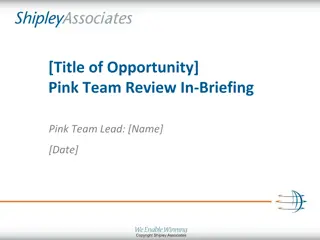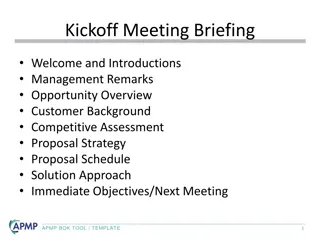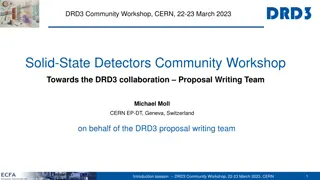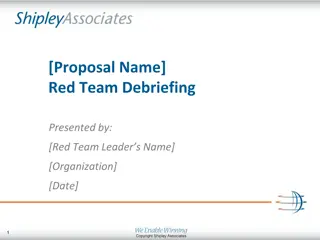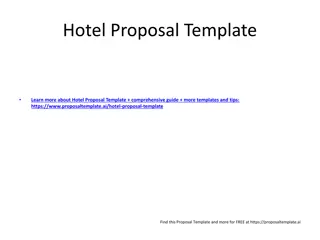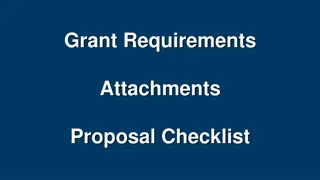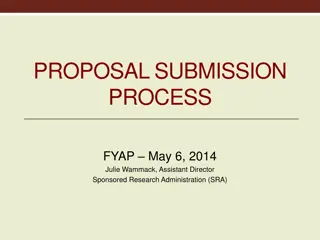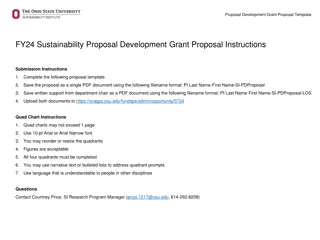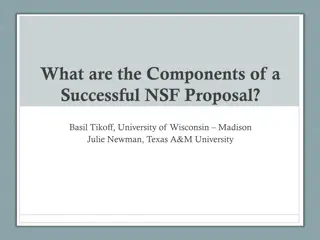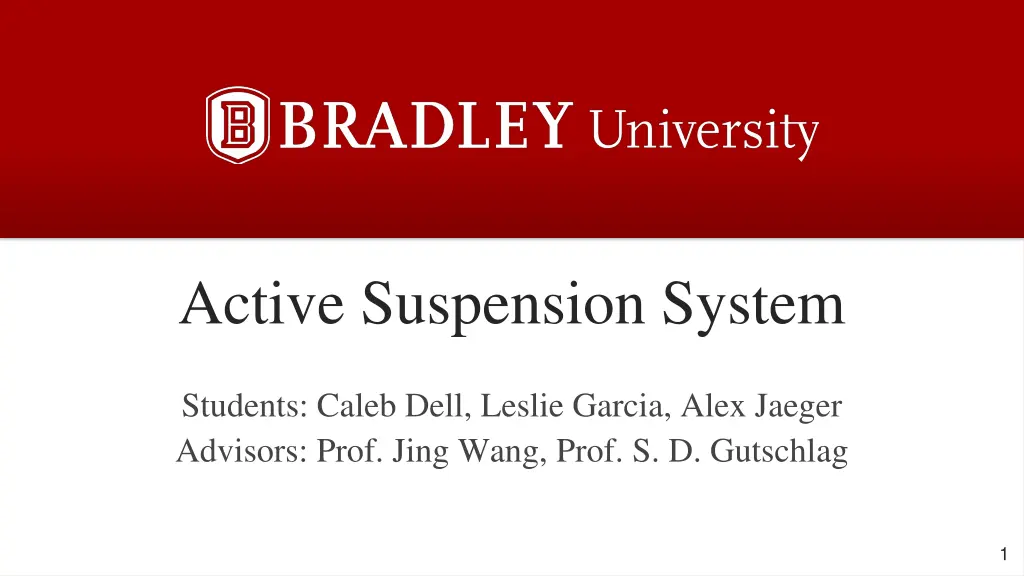
Optimizing Active Suspension System for Smooth Ride Experience
Design an active suspension system to reduce vertical disturbances in a suspended body, providing passengers a comfortable ride by minimizing terrain-induced vibrations. The project involves various components such as linear actuators, H-bridge, microcontrollers, and position sensors. Previous works include constructing and enhancing the system over years, including upgrading components like the linear actuator and organizing electronics for better performance. Critical electrical hardware components like voltage regulators and power relays play a crucial role in ensuring the system's functionality.
Download Presentation

Please find below an Image/Link to download the presentation.
The content on the website is provided AS IS for your information and personal use only. It may not be sold, licensed, or shared on other websites without obtaining consent from the author. If you encounter any issues during the download, it is possible that the publisher has removed the file from their server.
You are allowed to download the files provided on this website for personal or commercial use, subject to the condition that they are used lawfully. All files are the property of their respective owners.
The content on the website is provided AS IS for your information and personal use only. It may not be sold, licensed, or shared on other websites without obtaining consent from the author.
E N D
Presentation Transcript
Active Suspension System Students: Caleb Dell, Leslie Garcia, Alex Jaeger Advisors: Prof. Jing Wang, Prof. S. D. Gutschlag 1
Outline 1. Project Summary 2. Previous Work 3. System Block-Diagram 4. Component Descriptions 5. Functional Descriptions 6. Work Completed 7. Future Work 8. References 9. Questions 2
Project Summary Goal Design a system to minimize vertical disturbance of a suspended body Application Provide a gentle ride to passengers by removing disturbances imparted to a vehicle due to uneven terrain Apparatus Description: Lower Platform Linear Actuator H-bridge Microcontroller Upper Platform Position Sensor 3
Previous Work 1990-1991 Team Constructed apparatus 2006-2007 Team Replaced pneumatic cylinder with an electric linear actuator 4
Previous Work: 2016-17 team Organized H-bridge and associated electronics in an enclosure Heat Dissipation Added cooling fans Emergency control Limit switches Emergency stop 6
Hardware Components Upper & Lower Platform Position Sensor (Potentiometer) Safety Relays 4 pole, double throw Position Limit Switches Linear Actuator Motor Type: 160 volt brushed DC Maximum Load Capacity: 3600 N (810 [lbs]) Rotating Camshaft driven by a 3-phase induction motor controlled by a VFD 8
Critical Electrical Hardware Components LM317 Voltage Regulators (12[V]/1[A]) - Power for cooling fans LM7815 Voltage Regulators (15[V]) - Vcc for H-bridge LM7805 Voltage Regulator (5[V]) - Output side of the 6N137 optical isolator MY2N-D2 Power Relays - Used as safety relays 9
Critical Electrical Hardware Components Cont. 6N137 Optical Isolator MSK 4227 H-Bridge Maximum Current Rating 20 [A] at a case temperature of 25 C Maximum Voltage Rating 200 [V] Atmega128A Board (Embedded C) Operating Voltages: 2.7-5.5[V] Speed Grades: 0-16MHz 10
Testing the Microcontroller Subsystem Microcontroller tasks: Generate PWM signals at varying duty cycles Convert analog voltage signal from sensor potentiometer Compute position based on converted analog signal Alternate PWM signals for desired motor direction to maintain desired upper platform position 11
Microcontroller - Pins Used Output pins PB4 (OC0) and PB7 (OC2/OC1C) for generating two PWM signals to control the high-side transistors Input pin PF0 (ADC0) for ADC input Separately controlled output pins PC0 and PC1 to control the low-side transistors on the H-bridge PortA connected to LEDs to indicate position is within desired deadband 12
Microcontroller - PWM Signal Fast PWM mode Pre-scalar = 64 Frequency = 976 [Hz] OCR0 and OCR2 control duty cycle 13
Microcontroller - ADC Pin PF0 (ADC0) is used for ADC input 10-bit ADC 0-5 [V] range 5 [V] = 6 [in] (full length of actuator stroke) ADC input is used to compute current position 14
Work Completed Updated schematic diagram Three-phase motor safety relay connections corrected Built and tested discrete component H-bridge Used to verify software functionality Designed and conducted experiments to determine motor friction constants Tc and b Simulink models for the linear actuator Completed parts list 16
Three-Phase Motor Safety Relay 2016-2017 Team Three-phase was not functional Used updated schematic diagram to determine the wiring error Three-phase induction motor was initially connected to the normally closed pins instead of the normally open pins 18
Discrete Component H-Bridge Used to test the linear actuator control software Duty cycle must be less than 93% to ensure bootstrap capacitors recharge between cycles Bootstrap capacitors provide a floating voltage for the high- side transistors to use 19
Forward Motion Simulation Signal 1: Duty cycle generated by the waveform generator Signal 2: Voltage of the HINA gate Signal 3: Voltage across the Pittmann motor 21
Modeling Friction Constants Coulombic friction (Tc) and viscous damping coefficient (b) are not listed in actuator datasheet Experimental procedure to determine Tc and b Generated software to drive the linear actuator at a specific shaft speed for a specified time Measured average current flow to the actuator motor to compute generated torque Computed steady-state linear velocity Solved system of equations for Tc and b using and 2 22
Simulink Diagram Block diagram with omega ( ) 45 volts and 5lbs 23
Linear Velocity: Model vs. Experiment Linear Velocity (Model): 4.996 in/sec 45[V] applied to motor at 60% duty cycle with 5[lb] load Linear Velocity (Experiment): ~4.8 in/sec 45[V] applied to motor at 60% duty cycle with no-load 24
Simulink Diagram Block Diagram with 2 Conducted simulations with 45 [V] input and a 5 [lb] mass on actuator 25
Linear Velocity: Model vs. Experiment Linear Velocity (Model): 5.055 in/sec 45[V] applied to motor at 60% duty cycle with 5[lb] load Linear Velocity (Experiment): ~4.8 in/sec 45[V] applied to motor at 60% duty cycle with 5[lb] load 26
Parts List 27
Future Work Scheduled controller designs Bang Bang Controller Proportional Controller Percent overshoot Rise time Settling time Gain and phase margins Damping ratio Natural frequency 28
Future Work Cont. If time permits Proportional- Integrator (PI) Proportional-Integrator-Derivative (PID) Feedback component from position to acceleration 29
Future Division of Labor Caleb: Programming control theories in embedded C Leslie: Simulink and research Alex: Hardware and circuit design 30
Tentative Schedule Fall Semester 11/08/2018 - 11/28/18: Work on bang-bang control system 11/28/18-12/4/18: Website and proposal Spring semester 1/22/2019 - 4/20/2019: Finish with bang-bang and work on proportional system 4/16/2019 - 4/30/2029: If time allows, work on proportional-integral system and proportional-integral-derivative. 4/30/2019 - 5/10/2019: Work on final presentation, poster, and deliverables 31
References [1] A. Serreurier, J. Rose, C. Ramseyer, R. Vassey (2017): http://ee.bradley.edu/projects/proj2017/actss [2] A. Tantos, H-Bridges - The Basics. Modular Circuits, 2011. [Online]. Available: http://www.modularcircuits.com/blog/articles/h-bridge- secrets/h-bridges-the-basics/. [Accessed: Oct. 20, 2018] [3] Atmel, 8 bit Atmel Microcontroller with 128Kbytes In-System Programmable Flash, ATmega128/L Datasheet, 2011 [4] Avago, 2.5 Amp Output Current IGBT Gate Drive Optocoupler, HCPL-3120/J312 datasheet, March 21, 2016 [5] G. Franklin, D. Powell, and A. Emami-Naeini, Feedback Control of Dynamic Systems, Seventh. Pearson, 2015. [6] Industrial Devices Corp., Electric Cylinder Overview, EC2-H Series Datasheet [7] Maurey, Linear Motion Potentiometers, P1613 Datasheet [8] M. S. Kennedy Corp., 200 Volt 20 Amp MOSFET H-Bridge With Gate Drive, MSK 4227 Datasheet, November 2004 [9] Omron, Miniature Power Relays, MY4N-D2 Datasheet [10] STMicrocontrollers, N-Channel 250V 22A Power MOSFET, STP22NS25Z Datasheet [11] Texas Instruments, LM317 3-Terminal Adjustable Regulator, LM317 Datasheet 32
Questions 33
Equations 34


